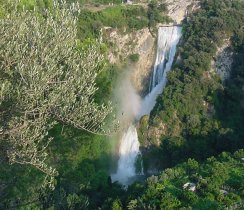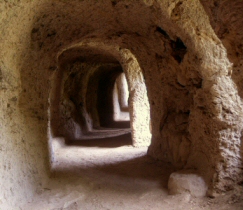Coming back and descending to the central part of the Park, we come across the Stipa Channel that was used in the past during the floods as an outlet arm of the Aniene river; then, we find the "Grotta di Nettuno" (Neptune Cave) and the "Grotta delle Sirene" (Sirens Cave), opened in the course of many centuries by the violent and strong Aniene waters that slowly corroded the rocks that still today reveal visions of impressing chasms to the visitor's eyes. The Neptune Cave is reachable through the Miollis Path, a tunnel in the heart of the rocks dug out by the French General, Governor of Rome, in 1809. In order to illuminate this path, Miollis had some window-openings built from which it was possible to bring in some light to watch the magnificent external landscape. But afterwards, in 1836, after the opening of the Gregorian underground passages, which diverted the course of the Aniene river towards the great artificial falls, a collapse occurred during the night between the 5th and the 6th of February. Cardinal Rivarola decided to open a flight of stairs and was the one who, among other things, ordered many different varieties of plants to be put in the garden of "Villa Gregoriana".
The name "Grotta delle Sirene" (Sirens Cave) was given by the painter Ducros, a famous landscapist; this artist, admiring the extraordinary and unique scenario of the rocks standing in this cave, located at the foot of the horrid and in which the waters coming from the Neptune Cave and from the Stipa Cascade fall, was led to imagine them as a fantastic place, inhabited by those splendid marine creatures that the legendary Sirens are. In order to avoid the eventuality that the "Grotta delle Sirene" would have the same fate as the Neptune Cave (the collapse occurred three years before), a wall was built in 1839 with the aim to strengthen it.
Above the Sirens Cave we can observe a natural bridge called "Ponte Lupo" (Wolf Bridge), that in the past was used by the local inhabitants possibly to move their cattle.
The reason why this place is called this way is not known despite many studies have been done on the subject; anyway, the same name has been given to another aqueduct's bridge located on the border of the San Gregorio da Sassola territory. This last Ponte Lupo is a lot more famous than the one located in Villa Gregoriana, having been painted by the aquarellist E.Roesler Franz who, being grateful for the beautiful gift of the honorary citizenship that he had received from the Municipality of Tivoli, donated it to the City. Still today, such splendid work is displayed in the Palazzo comunale of S.Bernardino.






